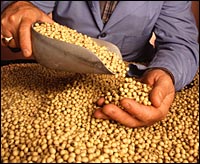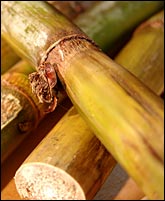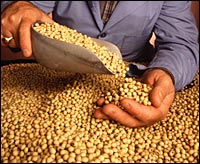In his drab office in the fashion-obsessed chaos of downtown Buenos Aires, Argentina, Edmundo Defferrari cuts a farmhand’s figure in a corporate man’s world.

Soy is growing up down south.
Photo: USDA/Keith Weller.
The 28-year-old industrial engineer, in cap, jeans, and scruffy beard, taps through a PowerPoint presentation choked with graphs, statistics, and cartoon renderings of how his prototype biodiesel plant can help farmers become self-sufficient. Then he opens a dark brown bottle filled with soybean diesel. “When it burns,” he says, “it smells like there’s a McDonald’s in the field.”
Backed by Don Mario, an Argentine seed company, Defferrari has developed what he hopes is a bit of methadone for global oil addiction: a localized way for soybean farmers to turn part of their harvest into homespun fuel. And this entrepreneur is far from alone. Kick-started by high oil prices and talk of peak oil, South America is making an incipient push to reshape the future of fuel.
It’s not an easy task. “International financial institutions, from the International Monetary Fund to the Inter-American Development Bank, have loaned with a favorable bias upon extractive industries, and little effort on renewables,” says Mark Langevin, a politics professor at Chapman University in Santa Maria, Calif., whose work focuses on Brazil. Observers also say that politics and economies of scale currently mean more noise than payoffs for the South American biofuel industry.
But that’s not stopping engineers in the continent’s agricultural powerhouses, particularly Brazil and Argentina, from exploring how to make and export cleaner fuels. And as the U.S. prepares to take its own biofuel production to another level, some are wondering if the global market will end up smelling more like salsa or apple pie.
Border Petrols
Defferrari hopes his $152,000 prototype plant in Chacabuco, about 145 miles west of Buenos Aires, will herald a trend that will become as common as cow dung. The plant can churn out about 360 gallons of biodiesel and 10 tons of animal feed from 12 tons of soybeans per day. Not only does it produce fuel that’s about half diesel’s market price, it’s automated, requiring humans only to load the contraption and turn it on and off.
“This is about farmer protection, about making them self-sufficient,” Defferrari says. “This is the kind of plant that three or four farmers could invest in together.” He’s got interest — and not just from farmers. His work has landed him in local magazines, in wire stories, and on CNN. And though he won’t give details, the budding entrepreneur says he is planning a trip to Chicago for meetings with a big energy firm.
In Argentina, which reaps high volumes of soybean and sunflower seeds, biodiesel is often pitched by industry watchers as the alternative fuel with the most national potential. But production in the country is currently at an “artisan level, of little volume,” says Claudio Molina, head of the Argentine Association of Biofuels. According to AgroDiario, an Argentina-based agriculture magazine, an estimated 20 plants are operating in the country, but they are not legally registered.
Some hope tighter regulation and legal subsidies will help cultivate the fledgling industry here. Argentine lawmakers are mulling a bill that would mandate a 5 percent mix of biodiesel with regular diesel, creating an annual demand of 660,000 tons by 2009. But the bill is stuck — unlike in Brazil, whose young biodiesel industry is helped by a mandated 2 percent mix by 2008, and 5 percent by 2013. Brazil opened its first commercial biodiesel refinery in March.
And South America’s biggest country is a leader in another important fuel. Last year, the global production of ethanol displaced about 3 percent of the 317 billion gallons of gasoline consumed on the planet, according to a report from the Renewable Energy Policy Network for the 21st Century. Nearly 40 percent of that global supply came from Brazil, the largest ethanol market and maker in the world.
Brasilia Arabia
It’s easy to imagine Eduardo Pereira de Carvalho as a loud-talking channeler of Henry Ford, whose 1920s enthusiasm for crop-based ethanol was eventually drowned by cheap oil. As head of the Sao Paulo Sugarcane Agroindustry Union, Carvalho speaks with a revolutionary’s flare, ticking off reasons why his country is the Saudi Arabia of ethanol.
Brazil produced 4 billion gallons of ethanol in 2004, some 37 percent of the world total, while the U.S. churned out 3.4 billion gallons, 31 percent of the world’s share. The country also exported 634 million gallons — 112 million of that to the U.S. — and its government is pushing to clear more land for production. Its vast size and tropical climate are perfect for the production of sugar cane, which is said to have better energy conversion rates than corn, the primary source for ethanol in the U.S. What’s more, Brazilian producers burn cellulosic stalk of sugar cane to make energy that fuels the entire industrial process. “That is why our production costs are half that of corn,” Carvalho says.
While Brazil builds its ethanol empire — eyeing customers from Venezuela to China — other South American nations are also getting on board. Most are embracing mandatory fuel mixes for cost, security, and environmental reasons, but some hope to become bio-fountains spilling into a global fuel revolution.
In September, Venezuela — which now mandates ethanol blending in some parts of the country and may require a 10 percent mix nationwide in the future — said it will spend $900 million over five years to bring 15 new plants online. Colombia passed a law requiring a 10 percent ethanol mix in cities with populations over 500,000, but geography restricts its sugar cane production, meaning it will likely have no exportable surplus. Peru is pushing ethanol, with California as a potential market, while Argentina is putting its ethanol empanada in the mix too. It has become the world’s 17th-biggest ethanol maker, producing 42 million gallons last year, according to F.O. Licht (though its output goes mainly to agrochemicals, drinks, and cosmetics). And tiny Paraguay and Uruguay are also seeking to get involved.
That said, nobody holds a caipirinha to Brazil, whose confluence of geography, economics, and politics has spawned an industry that, unlike the U.S.-based ethanol sector, is now capable of standing without the crutch of tax subsidies. And its fortunes rose three years ago when Brazilian automakers began churning out “flex-fuel cars” that run on a combination of power sources, including ethanol. Carvalho says the country’s car industry is heading to 100 percent flex fuel, and predicts that “within a year or so there will be no more new gas cars made in Brazil.” In early November, automakers rolled out a flex-fuel car that will be sold in the U.S. next year. While all that makes some U.S. ethanol makers nervous, Carvalho and others say there’s room for collaboration. In April, Brazil’s minister of development, industry, and foreign trade, Luiz Fernando Furlan, traveled to California on an ethanol cheerleading tour. While there, he suggested that U.S. and Brazilian companies could jointly market their products to China, widely considered to be the globe’s emerging mega-consumer of energy.
Fuelish Notions
Such a partnership would be a new spin on an old story. Thanks to geography, Uncle Sam has historically been a fossil-fuel friend of its Latin American neighbors, buying black gold from oil-flush nations like Ecuador and Venezuela, which provides some 10 percent of all U.S. oil imports. For many, those historic relations and proximity make bio-imports a no-brainer. But will the U.S. ethanol industry, which some see as a subsidy-heavy pet project of farm-belt politicians, fight that flow? Early signs point to yes.
For instance, U.S. ethanol makers now have their corn boiling over plans by U.S.-based Cargill to build a refinery in El Salvador. The ag giant will take advantage of a trade-law loophole in the Caribbean Basin Initiative: by processing Brazilian ethanol in a CBI signatory country, Cargill can export the fuel duty-free into the U.S. The Central American Free Trade Agreement could have closed the loophole, but didn’t.

Cane you dig it?
Photo: iStockphoto.
In reports and position papers, the Minneapolis-based Institute for Agriculture and Trade Policy, a think tank, claimed CAFTA could let millions of gallons of Brazilian ethanol into the U.S. without tariffs. “CAFTA stands to destroy thousands of jobs created by the U.S. ethanol industry and make the U.S. dependent yet again on foreign fuel supplies,” says Ben Lilliston of IATP.
And what about the U.S. biodiesel industry, a neophyte with production rates of only 30 million gallons last year? South America will not likely find new amigos there, especially after a boat full of South American biodiesel docked in Florida last month, qualifying for a U.S. biodiesel tax break. The American Soybean Association immediately called on Congress to eliminate a loophole in the 2004 law in question.
Some things are going well for the U.S. biofuel market, like the odd assortment of environmentalists, evangelical Christians, and conservatives running around Washington pitching it as a key to America’s fuel security. Lawmakers are drumming up ways to protect ethanol makers from a deluge of imports, and the energy bill President Bush signed this summer requires the country to use an annual 7.5 billion gallons of ethanol and biodiesel by 2012.
But America’s homespun biocombustibles industry, especially ethanol, is still in a knot over South American competition. Um, samba lessons anyone?


